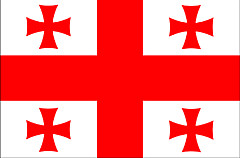|
Georgia

|
||||||||||||||||||||||||||||||||||||||||||||||||||||||||||||||||||||||||||||||||||||||||||||||||||||||||||||||||||||||||||||||||||||||||||||||||||||||||||||||||||||||||||
More information
(non-compulsory):
1.
General
overview of the Georgian regions and
history. More
resources
about Georgia:
|
|||||||||||||||||||||||||||||||||||||||||||||||||||||||||||||||||||||||||||||||||||||||||||||||||||||||||||||||||||||||||||||||||||||||||||||||||||||||||||||||||||||||||||
 Georgian Flag More detailed information. |
|
||||||||||||||||||||||||||||||||||||||||||||||||||||||||||||||||||||||||||||||||||||||||||||||||||||||||||||||||||||||||||||||||||||||||||||||||||||||||||||||||||||||||||
|
You can listen to each sound by clicking on the small blue arrows. Column 2 shows transcription that we use in our course, and column 3 indicates where you can find the Georgian letters on your keyboard. You have to install a Georgian font or activate Georgian unicode on your computer to be able to type in Georgian
Watch the video lecture by Shorena and learn the Georgian alphabet. Click here. |
||||||||||||||||||||||||||||||||||||||||||||||||||||||||||||||||||||||||||||||||||||||||||||||||||||||||||||||||||||||||||||||||||||||||||||||||||||||||||||||||||||||||||
|
Watch this clip and learn
how to spell Georgian letters
http://www.youtube.com/watch?v=rfTOTcTqf2I
|
||||||||||||||||||||||||||||||||||||||||||||||||||||||||||||||||||||||||||||||||||||||||||||||||||||||||||||||||||||||||||||||||||||||||||||||||||||||||||||||||||||||||||
|
ქართული ანბანი kartuli anbani Information about pronunciation and
how to write the modern Georgian letters
The description of pronunciation (articulation) of
the Georgian sounds and the spelling of the
corresponding letters are based on Amiran
Lomtadze, We learn to write and read Georgian,
Tbilisi, 1997, and Rusudan Asatiani, Georgian Language
for Foreigners, Tbilisi, 1996. It should be pronounced as glottalised ("hard") h and never as ks. |
|||||||||||||||||||||||||||||||||||||||||||||||||||||||||||||||||||||||||||||||||||||||||||||||||||||||||||||||||||||||||||||||||||||||||||||||||||||||||||||||||||||||||||
|
There is one shared pronoun ის [is]for everything that is expressed in English by the pronouns: he, she, it, that, whereas the pronoun ეს [es] means the same as the pronoun this. ის [is] - he, she, it, that
ეს [es] - this Listen to the recordings, make sure to repeat each phrase out loud and memorize the sentences: რა არის ეს? ra aris es? What is this? ეს არის სკოლა. es aris sk'ola. This is a school. რა არის ეს? ra aris es? What is this? ეს არის მანქანა. es aris mankana. This is a car. ვინ არის ის? vin aris is? Who is he? ის არის დავითი. is aris Daviti. He is Davit. You see the difference
between the Georgian and English spelling of the
name. The vowel -i is attached to the end of the
name in Georgian: Davit-i. The last vowel -i is a
nominative case marker.
The proper noun Davit ends in a consonant (in particular, in the consonant -t). In Georgian, it takes the nominative case marker -i: დავით-ი. ვინ არის ის? vin aris is? Who is she? ის არის ანა. is aris Ana. She is Anna. The proper noun ანა ends in a vowel (in
particular, in the vowel -a) and it does not take
the nominative case marker -i.
Note: there are no geminated consonants in Georgian. The proper noun Anna is being pronounced and spelled ანა [ana] in Georgian. |
||||||||||||||||||||||||||||||||||||||||||||||||||||||||||||||||||||||||||||||||||||||||||||||||||||||||||||||||||||||||||||||||||||||||||||||||||||||||||||||||||||||||||
Learn the following numerals. Memorize the words and letters:
|
Exercises:
1. Match the words (Women's names) 2. Match the words (Men's names) 3. Match the words (Men's names) 4. Match the words (Women's names) 5. Listen to the recordings, find the words, and learn them! 6. Build the words and learn to count in Georgian! (one to ten) Additional course material: |
||||||||||||||||||||||||||||||||||||||||||||||||||||||||||||||||||||||||||||||||||||||||||||||||||||||||||||||||||||||||||||||||||||||||||||||||||||||||||||||||||||||||||
| Additional links about Georgian Alphabet: http://www.aboutgeorgia.ge/language/alphabet.html http://www.georgianweb.com/language/3dalphabet/3dalphabet.html |
Additional links about Georgian Alphabet: http://www.ancientscripts.com/georgian.html http://www.omniglot.com/writing/georgian2.htm http://www.aboutgeorgia.ge/language |
||||||||||||||||||||||||||||||||||||||||||||||||||||||||||||||||||||||||||||||||||||||||||||||||||||||||||||||||||||||||||||||||||||||||||||||||||||||||||||||||||||||||||
| |
|||||||||||||||||||||||||||||||||||||||||||||||||||||||||||||||||||||||||||||||||||||||||||||||||||||||||||||||||||||||||||||||||||||||||||||||||||||||||||||||||||||||||||

